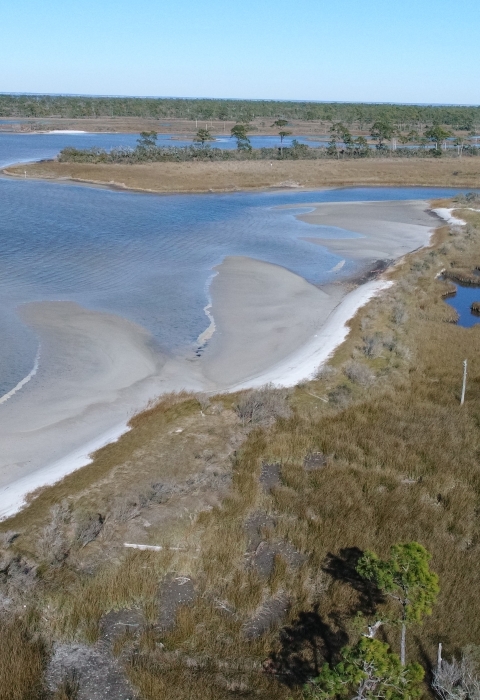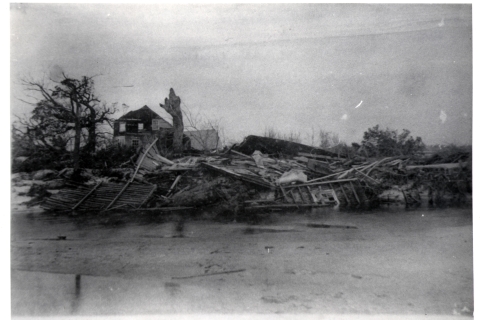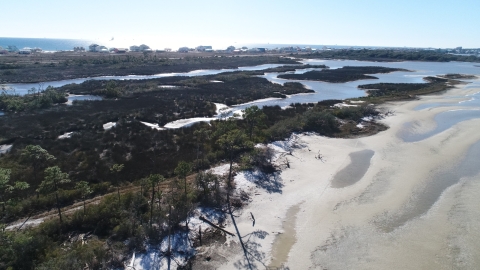Perched atop a lookout tree on Mobile Point in coastal Alabama, a man scanned the horizon for any shapes moving in the distance. He was looking for the familiar sight — a sail approaching the bay.
As a bar pilot around the year 1817, the man knew that sail was his source of income: a ship, approaching the unidentified sandbars of Mobile Bay. Helping that ship navigate the Mobile Bar so it could transport or receive their cargo was his special skill set.
But first, he had to get the job. Once spotted, the race was on. He had to beat the other bar pilots vying for the opportunity to guide the ship. The fastest pilot got the payday.
Within this boat race, played out daily on the southern edge of St. Andrews Bay on the Fort Morgan peninsula, lies the origin of a coastal Alabaman community historically known as Pilot Town. Named after the residents that occupied and worked in the area, Pilot Town began as a group of bar pilots competing for navigation jobs. However, the pilots and their families evolved into a utopian society of shared land, shared business, and commune-style togetherness.
The “utopian” moniker doesn’t only apply to the historical town. The area’s sandy shrub scrub, coastal marsh, and several brackish inland lagoons provide incredible habitat for a host of species. Migratory birds use the area as vital nesting grounds and stop over habitat on their long journeys. Another species, humans, appreciate Pilot Town’s beauties, too.
Pilot Town’s gifts --- its historical artifacts, ecological significance, and natural beauty --- will be secure forever. As part of the Deepwater Horizon Natural Resource Damage Assessment Regionwide Trustee Implementation Group’s first restoration plan, Pilot Town is being acquired as part of Bon Secour National Wildlife Refuge.
But first, some history.
A Utopian Community of Navigators
Bar pilots weren’t unique to Pilot Town. There were bar pilots in Alabama focused on the bar on the Upper Dog River. And, farther west, pilots guided vessels entering the Columbia River in Oregon. Ship captains needed their services. Before dredging was commonplace in maritime navigation, bar pilots were essential for large ships to safely transport or receive their cargo. The Alabama State Pilotage Commission, which was created in 1852 and is still acting today, requires that ships use bar pilots “to help prevent ship collision, stranding and damage, with attendant loss of life and property and perhaps even environmental damage.”
In an industry where competition was a daily event, Pilot Town stood apart. In 1865, seeing the benefit of working as a group instead of battling it out amongst themselves, the pilots formed the Mobile Bar Pilots Association.
Now, formalizing an association does not in and of itself create a utopia. It is the way these pilots and their families lived together in their town that created such a community. Located on a small area of beach 30 miles southeast of the Port of Mobile, the Pilot Town houses lined up along the southern Alabama marshes with Mobile Bay to the north and the Gulf of Mexico to the south. On this narrow stretch of land, the families didn’t divvy up lots and have defined ownership of each area. Instead, they co-owned the entire area. If there was a problem, they came together and found a solution. When the business brought in profits, they shared it equally. It worked; business was good.
The homes that the pilots lived in were not small rickety shacks. They were rather nice houses. Several of the homes were two story with double balconies to sit out and enjoy the coastal breeze. All the houses had a clear view of the sea to watch ships coming and going. With the white sandy beaches as their backyard and all the resources at their fingertips, the community thrived. Artifacts found within the area showed that the residents dined using fine china and crystal.
The utopia did not last forever. A hurricane wiped out the community on September 27, 1906.
“We have a long history of hurricanes here in coastal Alabama,” said Donnie Barrett, director emeritus of the Fairhope Museum. “But this one, a category 4 (sustained winds up to 156 mph), hit them just right. It pushed the Gulf over the peninsula and washed the people and their homes away.”
Maude Midgette, a Pilot Town resident, may have summed up the storm best. “The Gulf was washing our clothes off,” she recalled, “and the wind was blowing the hair out of our heads.”
Traumatized by the storm, the surviving residents never came back to re-establish the community. Pilot Town faded into history.
An Undeveloped Oasis
The land near Pilot Town today bears no resemblance to the terrain from a century ago. Fort Morgan peninsula now comprises vacation homes, resorts, and local businesses. The western portion of Gulf Shores, Alabama, is a sought-after destination for its beautiful vistas and recreational opportunities.
Then there is Pilot Town, some of the best wildlife habitat within a very developed area.
The vanished community’s communal ethos likely helped save the land from developers. Due to the land’s utopian history and the lack of delineated property lines, it was very difficult to determine who actually owned the land. Efforts to determine ownership spanned decades, affording the tract to remain intact over all the years.
But not for a lack of trying.
In the early 2000’s, a Chicago-based development firm had purchased around 148 acres of coastal property that included a portion of the Pilot Town tract. The company bought the land from a family for more than $18 million. It planned to build a high-end marina and residential development, including a private beach using sediment dredged from the bay.
However, when the firm filed with the U.S. Army Corps of Engineers to get a permit to dredge and fill, it ran into nearly uniform opposition. Responses from federal and state conservation agencies, non-profit organizations, and the public noted the dramatic impact the development would have on the historical and environmental integrity of Pilot Town and the surrounding area. The then-director of the Dauphin Island Sea Lab, George Crozier, wrote, "I don't think that I have seen a proposal for a residential development that I thought would have a greater impact on natural features than this one.”
After reviewing the comments, the Army Corps requested the firm do a more thorough examination of less environmentally damaging alternatives to the project. In time, the developers gave up. The project was abandoned, and the land was left mostly undisturbed.
A Safe Harbor for Pilot Town
Over the years, attempts to conserve the land at Pilot Town have gain some traction. Given the property’s pristine and undisturbed nature, conservation agencies and non-profit organizations have long been working for Pilot Town to be left alone.
Oddly, help came by disaster.
In 2010, the Deepwater Horizon oil spill killed 11 people and caused widespread ecological harm to the Gulf of Mexico. Oil slicks covered more than 43,000 square miles of the Gulf’s surface, and more than 1,300 miles of shoreline were oiled. Thousands of birds, sea turtles and marine mammals were killed. From this disaster rose opportunity for restoration.
Six years later, a historic settlement agreement through the Natural Resources Damage Assessment process was signed and included $8.8 billion for restoration. Through these settlement funds, the U.S. Fish and Wildlife Service collaborated with the Alabama Department of Conservation and Natural Resources and The Nature Conservancy to acquire Pilot Town as part of the Bon Secour National Wildlife Refuge.
The project is part of the Regionwide Trustee Implementation Group’s Restoration Plan 1, to address the conservation and enhancement of nesting and foraging habitats for birds. Overall, the Restoration Plan includes a portfolio of projects restoring sea turtles, marine mammals, oysters, and birds. The Plan provides nearly $100 million for 11 restoration projects across the Gulf region. The Pilot Town project costs $6.5 million.
A Utopia Preserved
Bon Secour National Wildlife Refuge is little, but important. It is one of the most important stop-over sites for migratory birds. It also plays a critical role for endangered species such as the Alabama beach mouse, nesting sea turtles, and wintering piping plovers.
“We are so grateful to our partners for their decades of hard work and strong support for this project,” said Jereme Phillips, U.S. Fish and Wildlife Service Refuge Complex Manager at the Gulf Coast National Wildlife Refuge Complex. “While the Pilot Town acreage is relatively small it has an enormous importance for the refuge due to its significant cultural, historical, and natural resources.”
Locals and tourists love Bon Secour. Folks come to the refuge to walk its trails, visit its beaches, and catch a glimpse of some of the 360 different species of birds seen on the refuge. And, due to agency and organizational support, along with the community’s active engagement to preserve Pilot Town, the tract will continue to support the birder’s paradise that is coastal Alabama. With pristine breeding habitat for marsh birds, and stopover habitat for migrating Neotropical birds, the formerly inhabited area remains a utopia for its feathered residents.
But, Pilot Town is not solely for the birds. The marsh serves as a nursery for crabs, shrimp, sea turtles and other marine life.
“Conserving the habitat of Pilot Town is ecologically and historically vital,” said Steve Northcutt, Director of Protection with the Alabama Chapter of The Nature Conservancy. “On top of that, it is also important to the local economy. Through the collaborative restoration effort that resulted from Deepwater Horizon disaster, we are able to ensure this property remains a pristine gem on the Alabama coast.”
In other words, Bon Secour is the perfect place for a one-time utopia. It’s no wonder that “Bon Secour” comes from the French meaning "safe harbor.”








